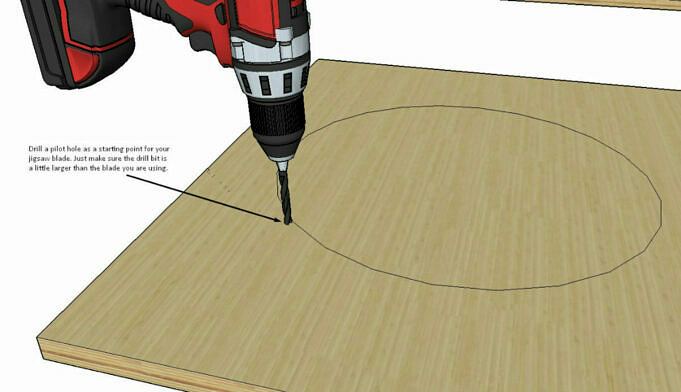Are you looking for a way to make three holes in a piece wood but don’t know how to use the jigsaw properly?
The jigsaw can be used to cut curves into wood and create well-placed holes. We’ll show you how.
This guide will help you complete your project quickly. You’ll get perfect results every single time you follow our steps.
3 Holes To Be Cut With A Jigsaw.
These are the steps to make 3 holes using a jigsaw.
1. The right saw blade is important. The best saw blade for you depends on the material that you are cutting. A hacksaw blade is best for metal. A fine-tooth saw blade is best for wood and plastic.
2. Mark the spot where you will cut the hole in the material. To make sure your markings are accurate, you can use a ruler and a straight edge.
3. The clamp should be tightened after aligning the blade with the markings. Before tightening the clamp, make sure the blade faces in the right direction. If it is not, the cut won’t be straight.
4. Slowly start cutting and speed up as you get closer the end. You must maintain control over the saw, especially when cutting intricate shapes or curves.
5. Once you’re done cutting, release your clamp and take the blade out of the material. Make sure to clean up all debris and then admire your work!
Tips To Cut Curves:
You should position your material flatteningly if you have to cut a curve. This will allow you to maintain control and create a smoother cut.
To make the curve more precise, you can also use a piece or wood as a guide. Simply clamp the wood and use the jigsaw to trace the curve.
Safety Tips
These are safety tips to keep in mind when you cut three holes using a jigsaw.
1. Always read the instructions manual before you use any power tool.
2. Wear safety goggles to shield your eyes from debris.
To avoid injury, use a clamp or saw stand to secure the workpiece.
4. Keep fingers and other body parts away from the blade at all costs.
Some Common Mistakes:
These are the most common mistakes made when you cut 3 holes using a jigsaw.
1. It is important to properly secure the workpiece.
2. Use the wrong blade for the material to be cut.
3. You are not following the correct line.
4. Too fast.
5. Not finishing the cut correctly.
These are the 3 mistakes you need to avoid and make sure that you cut every hole perfectly.
1. Make Sure You Secure The Workpiece Correctly
You can clamp it down or use another method so it doesn’t move when you are cutting.
2. Make Sure You Use The Correct Blade To Cut The Material.
A metal-cutting knife for metal and a wood-cutting knife for wood, etc.
3. Follow The Line:
Mark the line with a pencil and ensure you keep it in place.
4. Take Your Time And Cut Slowly.
Do not rush, do not go too fast or force the blade. Let the blade do its job.
5. Complete The Cut Correctly:
When you reach the end of your cutting line, slow down. Carefully guide the blade away from the workpiece. Do not let the blade snap off of the workpiece.
FAQs:
Which Type Of Saw Blade Do You Need To Cut Holes In The Wood?
The size and depth of your hole will determine the type of saw blade that you use to cut it in wood. A standard jigsaw can be used to cut small holes. You will need a specialized blade such as a spade bit or hole saw to cut deeper holes.
How Do You Hold The Jigsaw While Cutting?
There are many ways to hold the jigsaw while you’re cutting. It is important to keep your fingers and hands clear of the blade, and to hold the saw in a firm grip. It is best to hold the saw with both hands and keep your arms close to your body.
Which Type Of Jigsaw Do You Need To Cut Holes In Wood?
There are many jigsaws available on the market. All types can be used to cut holes in wood. If you plan to do a lot of hole-cutting you might want to get a specialty jigsaw such as a spade bit or hole saw.
Conclusion:
That’s it! Now you know how to use a jigsaw to cut three holes. Take your time and be patient. This is a precise tool, and you might not achieve the results you want if you hurry.
Once you’ve mastered the basics, try out different sizes and shapes to find what works best for you. Have fun, and have fun sewing!



